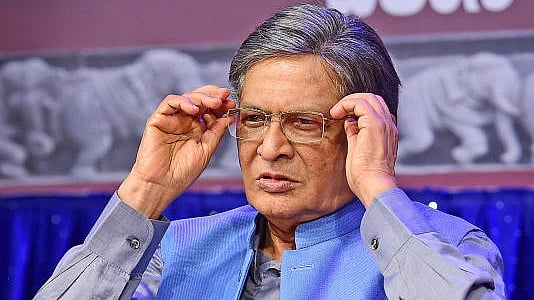
Former Karnataka Chief Minister S M Krishna
Credit: DH Photo
I first met S M Krishna when I welcomed him while boarding a Deccan helicopter at the Jakkur Aerodrome, Bengaluru. He was on way to Sri Adhichunchanagiri Mahasamsthana Math to take blessings from the seer late Sri Balagangadharanatha Swamiji, the religious head of powerful Gowdas or the Vokkaliga farming community. The Congress high command anointed Krishna who was the frontrunner to be sworn in as chief minister in October 1999.
What struck me at first sight was that Krishna was dignified, sophisticated, soft spoken, and stylishly but elegantly attired. His English was polished but he was also at ease in old Mysore Kannada. He said “Captain, why don’t you join me for the ride?” Delighted, I hopped on board for the 30-minute ride. That was the beginning of a long and memorable association.
It didn’t take long to occur to me that beneath his urbane manners he was politically savvy and astute. It was generally felt that H D Deve Gowda, his rival in politics, was the true son of the soil and the authentic leader of the Vokkaliga community. Somehow other leaders, including Krishna who hailed from the same caste, did not capture the imagination or evoke similar feelings among the community.
Paying obeisance to the seer who wielded enormous influence among Vokkaligas, whose mutt ran engineering colleges, medical colleges, hospitals, and hundreds of schools in rural areas across the old Mysore state made eminent sense. Krishna was as much a leader of his community as Deve Gowda, hailing from a small village in Mandya district, which is a rural bastion of the Vokkaligas.
Krishna succeeded to a great degree in making his community proud; however, aided by his US education and his extraordinary vision to make Bengaluru a global iconic cosmopolitan city and IT hub, he transcended all narrow caste limitations that endeared him across all sections of society.
Krishna’s idea to connect smaller towns
The seeds of my dream for a low-cost airline were sown fortuitously during my interactions with Krishna.
He frequently used Deccan helicopters. One day he expressed his wish to visit the temple at Palani, Tamil Nadu, on an aeroplane and not a helicopter which was too noisy and took more time. Air Deccan had a couple of modern pressurised noiseless nine-seater planes which was apt for the job.
My pilot said we could fly the chief minister to Madurai (the nearest airport to Palani) and from there to Palani in a chopper. But that was cumbersome. After a while, the pilot said there was a small airstrip in Dindigul, which is about 60 kms from Palani.
The pilot and an engineer were sent to check if the airstrip was safe to land. The airstrip was adjacent to and belonged to a pre-Independence textile mill, and except for a few grazing cows it was safe to land. I spoke to the owner of the mill who was thrilled to see a plane land in his disused airfield and was happy to make it ready for the same.
Krishna was elated, flew to Dindigul, and paid a visit to the Palani temple. On his way back, he asked me, “Captain, why can’t you think of connecting all our small airfields in Karnataka in a similar manner?” And that got me thinking.
We studied the maps and realised that there were a little over 500 airstrips apart from the 70-odd airports used by various airlines! Some were of World War II vintage, some owned by state governments, a few by the private sector like Jamshedpur, and others by the Airport Authority of India and defence airstrips — none were connected by regular services. They were all in disuse and disrepair. Bellary itself had four airfields. In the 1930s, J R D Tata had landed on one of these a small plane carrying mail enroute to Madras from Karachi. No flight had landed there since then.
Air Deccan, with 48-seater planes, was inaugurated by Krishna from Bangalore to Hubli, Belgaum, and Bellary, and later to other smaller regional cities across India. With foresight, Krishna swiftly changed government rules authorising class two gazetted officers to travel by air within Karnataka realising the importance of officials reaching remote districts in the hinterland lands to serve the public.
Krishna from the great epic
Krishna was a man with great empathy, and always forthcoming to help new generation entrepreneurs from Karnataka. Soon after the launch of Air Deccan, we flew into headwinds with established full-service airlines who felt threatened by the rapid rise of our low-cost model. They used their political clout to ground Air Deccan citing low cost was unsafe. Members of Parliament raised questions demanding a safety audit and suspension of our operations. Air Deccan’s various clearances were put on hold and operations were about to come to a grinding halt.
I rushed to Krishna. He said “Captain, give me a day. Let me think.” Next day he asked me to meet Defence Minister George Fernandes. He said, “He admires you greatly as an entrepreneur and for being an ex-Army man. You also know him. These ministers can’t say no to him. It’s better George speaks to them instead of me.” George saab came as a godsend, and Air Deccan soared in the skies.
Krishna, as in the great epic Mahabharata who came to the rescue of his loved ones, rescued me and Air Deccan from ruin with no ignoble expectations from us.
Beyond that, he stood out for his decency in the world of vulgar and venal politics, and changed the face of Bengaluru not only in IT but biotechnology as well, and gave a spectacular and glittering international airport.
May he smile from the heavens.
(The author is a soldier, farmer, and entrepreneur)